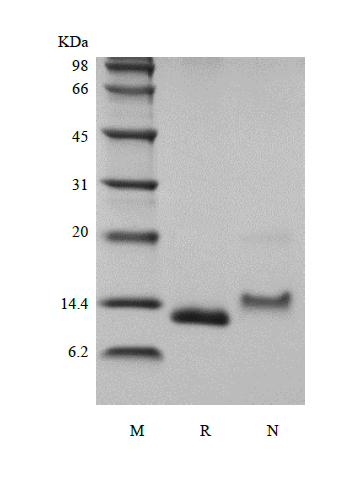- Synonyms
- HC11, Monocyte chemoattractant protein 1, MCAF, MCP-1, Monocyte secretory protein JE, Small-inducible cytokine A2
- Source
- Escherichia coli.
- Molecular Weight
- Approximately 8.7 kDa, a single non-glycosylated polypeptide chain containing 76 amino acids.
- AA Sequence
- QPDAINAPVT CCYNFTNRKI SVQRLASYRR ITSSKCPKEA VIFKTIVAKE ICADPKQKWV QDSMDHLDKQ TQTPKT
- Purity
- > 96 % by SDS-PAGE and HPLC analyses.
- Biological Activity
- Fully biologically active when compared to standard. The biological activity determined by a chemotaxis bioassay using human monocytes is in a concentration range of 10-100 ng/ml.
- Physical Appearance
- Sterile Filtered White lyophilized (freeze-dried) powder.
- Formulation
- Lyophilized from a 0.2 μm filtered concentrated solution in 20 mM PB, pH 7.4, 100 mM NaCl.
- Endotoxin
- Less than 1 EU/μg of rHuMCP-1/CCL2 as determined by LAL method.
- Reconstitution
- We recommend that this vial be briefly centrifuged prior to opening to bring the contents to the bottom. Reconstitute in sterile distilled water or aqueous buffer containing 0.1 % BSA to a concentration of 0.1-1.0 mg/mL. Stock solutions should be apportioned into working aliquots and stored at ≤ -20 °C. Further dilutions should be made in appropriate buffered solutions.
- Stability & Storage
- Use a manual defrost freezer and avoid repeated freeze-thaw cycles.
- 12 months from date of receipt, -20 to -70 °C as supplied.
- 1 month, 2 to 8 °C under sterile conditions after reconstitution.
- 3 months, -20 to -70 °C under sterile conditions after reconstitution.
- Usage
- This material is offered by Shanghai PrimeGene Bio-Tech for research, laboratory or further evaluation purposes. NOT FOR HUMAN USE.
- SDS-PAGE

- Reference
- 1. Carr MW, Roth SJ, Luther E, et al. 1994. Proc Natl Acad Sci U S A. 91:3652-6.
2. Yoshimura T, Yuhki N, Moore SK, et al. 1989. FEBS Lett. 244:487-93.
3. Furutani Y, Nomura H, Notake M, et al. 1989. Biochem Biophys Res Commun. 159:249-55.
4. Craig MJ, Loberg RD. 2006. Cancer Metastasis Rev. 25:611-9.
5. Conti P, Boucher W, Letourneau R, et al. 1995. Immunology. 86:434-40.
6. Bischoff SC, Krieger M, Brunner T, et al. 1992. J Exp Med. 175:1271-5.
7. Xia M, Sui Z. 2009. Expert Opin Ther Pat. 19:295-303.
8. Lloyd CM, Minto AW, Dorf ME, et al. 1997. J Exp Med. 185:1371-80.
- Background
- CCL2, also named monocyte chemotactic protein-1 (MCP-1) and small inducible cytokine A2, is a small cytokine that belongs to the CC chemokine family. It is a monomeric polypeptide, with a molecular weight of approximately 13 kDa and it is anchored in the plasma membrane of endothelial cells by glycosaminoglycan side chains of proteoglycans. Research shows that CCR2 and CCR4 are two cell surface receptors that bind CCL2. CCL2 exhibits a chemotactic activity for monocytes and basophils. However, it does not attract neutrophils or eosinophils. CCL2 has been implicated in the pathogenesis of diseases characterized by monocytic infiltrates, like psoriasis, rheumatoid arthritis or atherosclerosis and it may be involved in the recruitment of monocytes into the arterial wall during the disease process of atherosclerosis. Mature human CCL2 shares 78-79 % a.a. identity with canine, porcine and equine CCL2, while mouse and rat express a form of CCL2 that is extended by 49 a.a. and shares only ~56 % a.a. identity within the common region.







 COA申请
COA申请
